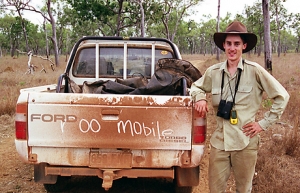Ecologist plans expedition to save roos
Research news
The kangaroo is one of the most recognisable icons in the world – second only to the Statue of Liberty.
Yet, while many of us living in Australia’s southern states see an abundance of kangaroos, a number of kangaroo and closely-related wallaby species may actually be disappearing at the other end of the country.
Deakin ecologist Dr Euan Ritchie is preparing for a three-month expedition across northern Queensland on a mission to help save these tropical mammals from extinction.
Dr Ritchie, from Deakin's Centre for Integrative Ecology, has launched a fundraising campaign, through the crowdfunding site Pozible, to raise around $15,000 to support his journey across the region west of Townsville and up to Cape York, to collect information on kangaroos and wallabies.
"We have genuine cause for concern because local Indigenous communities are telling us they are seeing fewer and fewer kangaroos and wallabies,” Dr Ritchie explained.
“It may be because there are too many fires at the wrong time of the year, due to current management practices that differ from traditional and indigenous fire regimes, climate change may be modifying species’ habitats, perhaps too many feral cats are dining out on the smaller wallabies, or, more likely, it’s a combination of all these factors!"
The trip marks Dr Ritchie’s second major expedition in northern Australia. He undertook his first about a decade ago - compiling substantial first-of-its-kind information as part of his PhD.
This time, he will revisit the same areas in Queensland to count roos and wallabies – and their poo – to discover which species live where and in what numbers, and how populations might have changed over the decade.
The mission is also personal, with Dr Ritchie's professional and personal lives intersecting through the evolution of his kangaroo project. He met his wife, Dr Jen Martin, a lecturer in science communication, at a conference in Sydney, while they were both researching mammals at opposite ends of the continent. Both originally from Victoria, they completed the project together.
"Ten years ago we were finishing up four years of fieldwork in some of Australia's most remote and spectacular habitats," Dr Ritchie said.
"We'd collected first-of-its kind information on four different species (antilopine wallaroo, common wallaroo, eastern grey kangaroo and agile wallaby). We worked out where they each occurred, how big the populations were and why each species lived in certain areas and not others.
"Since then, we've been blessed with two kids, health, happiness and so much more, but, unfortunately, our northern mammals haven't been so lucky over the same period.”
This time, the expedition will involve the whole family, who will pack up a tent and 4WD, along with the latest in modern technology, to facilitate their research, and communicate their findings to fellow scientists, supporters and other members of the public.
"This time around, our technology will include remotely-triggered camera traps, which will be particularly important for finding smaller species like the spectacled hare-wallaby," Dr Ritchie said.
“But it's not just about the data – we know how important (and fun) it is to talk with people about what we're doing and why. We'll write a regular blog, with posts from the field, roos, flies, crocodiles and all.
"Sadly, Australia doesn't have a good track record when it comes to mammal extinctions. Since 1788, we've lost more than ten per cent of our native mammals, of which nearly a third are kangaroos and their close relatives. It's devastating to think we could be on the road to losing more of these iconic animals, but we hope to help conserve them. We plan to give it our best shot.”
Share this story
 Dr Euan Ritchie on his first roo trip in 2002. (photo: Angus McColl).
Dr Euan Ritchie on his first roo trip in 2002. (photo: Angus McColl).
